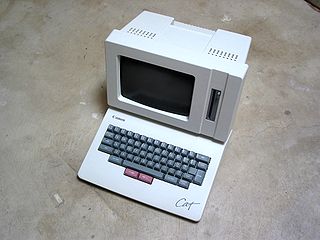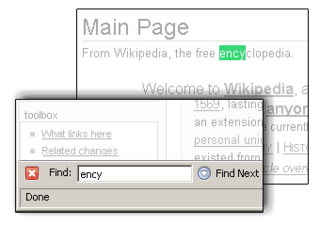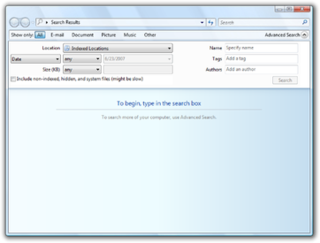Related Research Articles

In computing, a database is an organized collection of data stored and accessed electronically from a computer system. Where databases are more complex they are often developed using formal design and modeling techniques.
Information retrieval (IR) is the process of obtaining information system resources that are relevant to an information need from a collection of those resources. Searches can be based on full-text or other content-based indexing. Information retrieval is the science of searching for information in a document, searching for documents themselves, and also searching for the metadata that describes data, and for databases of texts, images or sounds.
A search engine is an information retrieval system designed to help find information stored on a computer system. The search results are usually presented in a list and are commonly called hits. Search engines help to minimize the time required to find information and the amount of information which must be consulted, akin to other techniques for managing information overload.

In the industrial design field of human–computer interaction, a user interface (UI) is the space where interactions between humans and machines occur. The goal of this interaction is to allow effective operation and control of the machine from the human end, while the machine simultaneously feeds back information that aids the operators' decision-making process. Examples of this broad concept of user interfaces include the interactive aspects of computer operating systems, hand tools, heavy machinery operator controls, and process controls. The design considerations applicable when creating user interfaces are related to, or involve such disciplines as, ergonomics and psychology.

Jef Raskin was an American human–computer interface expert best known for conceiving and starting the Macintosh project at Apple in the late 1970s.

Canon Cat is a task-dedicated desktop computer released by Canon Inc. in 1987 at the price of U.S. $1,495. On the surface, it was not unlike dedicated word processors popular in the late 1970s to early 1980s, but it was far more powerful, and incorporated many unique ideas for data manipulation.
In computer programming, create, read, update, and delete (CRUD) are the four basic operations of persistent storage. CRUD is also sometimes used to describe user interface conventions that facilitate viewing, searching, and changing information using computer-based forms and reports. The term was likely first popularized by James Martin in his 1983 book Managing the Data-base environment.

Code folding or less commonly holophrasting is a feature of some text editors, source code editors, and IDEs that allows the user to selectively hide and display – "fold" – sections of a currently edited file as a part of routine edit operations. This allows the user to manage large amounts of text while viewing only those subsections of the text that are specifically relevant at any given time.
In computing, an interface is a shared boundary across which two or more separate components of a computer system exchange information. The exchange can be between software, computer hardware, peripheral devices, humans, and combinations of these. Some computer hardware devices, such as a touchscreen, can both send and receive data through the interface, while others such as a mouse or microphone may only provide an interface to send data to a given system.

Content-based image retrieval, also known as query by image content (QBIC) and content-based visual information retrieval (CBVIR), is the application of computer vision techniques to the image retrieval problem, that is, the problem of searching for digital images in large databases. Content-based image retrieval is opposed to traditional concept-based approaches.

The Humane Interface: New Directions for Designing Interactive Systems (ISBN 0-201-37937-6) is a book about user interface design written by Jef Raskin and published in 2000. It covers ergonomics, quantification, evaluation, and navigation.

In computing, incremental search, incremental find or real-time suggestions is a user interface interaction method to progressively search for and filter through text. As the user types text, one or more possible matches for the text are found and immediately presented to the user. This immediate feedback often allows the user to stop short of typing the entire word or phrase they were looking for. The user may also choose a closely related option from the presented list.
The semantic gap characterizes the difference between two descriptions of an object by different linguistic representations, for instance languages or symbols. According to Andreas Hein, the semantic gap can be defined as "the difference in meaning between constructs formed within different representation systems". In computer science, the concept is relevant whenever ordinary human activities, observations, and tasks are transferred into a computational representation.
Archy is a software system whose user interface introduced a different approach for interacting with computers with respect to traditional graphical user interfaces. Designed by human-computer interface expert Jef Raskin, it embodies his ideas and established results about human-centered design described in his book The Humane Interface. These ideas include content persistence, modelessness, a nucleus with commands instead of applications, navigation using incremental text search, and a zooming user interface (ZUI). The system was being implemented at the Raskin Center for Humane Interfaces under Raskin's leadership. Since his death in February 2005 the project was continued by his team, which later shifted focus to the Ubiquity extension for the Firefox browser.

Ben Shneiderman is an American computer scientist, a Distinguished University Professor in the University of Maryland Department of Computer Science, which is part of the University of Maryland College of Computer, Mathematical, and Natural Sciences at the University of Maryland, College Park, and the founding director (1983-2000) of the University of Maryland Human-Computer Interaction Lab. He conducted fundamental research in the field of human–computer interaction, developing new ideas, methods, and tools such as the direct manipulation interface, and his eight rules of design.
In user interface design, a mode is a distinct setting within a computer program or any physical machine interface, in which the same user input will produce perceived results different from those that it would in other settings. Modal interface components include the Caps lock and Insert keys on the standard computer keyboard, both of which typically put the user's typing into a different mode after being pressed, then return it to the regular mode after being re-pressed.

Windows Search is a content index desktop search platform by Microsoft introduced in Windows Vista as a replacement for both the previous Indexing Service of Windows 2000 and the optional MSN Desktop Search for Windows XP and Windows Server 2003, designed to facilitate local and remote queries for files and non-file items in compatible applications including Windows Explorer. It was developed after the postponement of WinFS and introduced to Windows constituents originally touted as benefits of that platform.
Natural-language user interface is a type of computer human interface where linguistic phenomena such as verbs, phrases and clauses act as UI controls for creating, selecting and modifying data in software applications.

A command-line interface (CLI) processes commands to a computer program in the form of lines of text. The program which handles the interface is called a command-line interpreter or command-line processor. Operating systems implement a command-line interface in a shell for interactive access to operating system functions or services. Such access was primarily provided to users by computer terminals starting in the mid-1960s, and continued to be used throughout the 1970s and 1980s on VAX/VMS, Unix systems and personal computer systems including DOS, CP/M and Apple DOS.
FLOW is an educational programming language designed by Jef Raskin and Jonathan (Jon) Collins, an undergraduate student in the UCSD Art Department, in 1970 and implemented on several minicomputers in the early 1970s. The goal of the language is to make it easy to explore algorithms through a highly interactive environment. The overall language is very similar in syntax and structure to the BASIC programming language, but has a number of changes in order to make typing code easier. Most notable among these was the concept of "typing amplification", in which short strings, often a single character, were expanded by the language into the complete "unamplified" source code. Modern integrated development environments and code-oriented text editors often include a similar feature, now normally referred to as autocomplete. The beginning programmer would first create a flow chart to solve the problem. Since the all of problems involved words the solution was intuitive. The flow chart would be translated into the flow programming language using a top-down, mechanical method.
References
- ↑ Raskin, Jef (2000-04-08). The Humane Interface . Addison-Wesley Professional. pp. 126. ISBN 978-0-201-37937-2. Read Text on Internet Archive